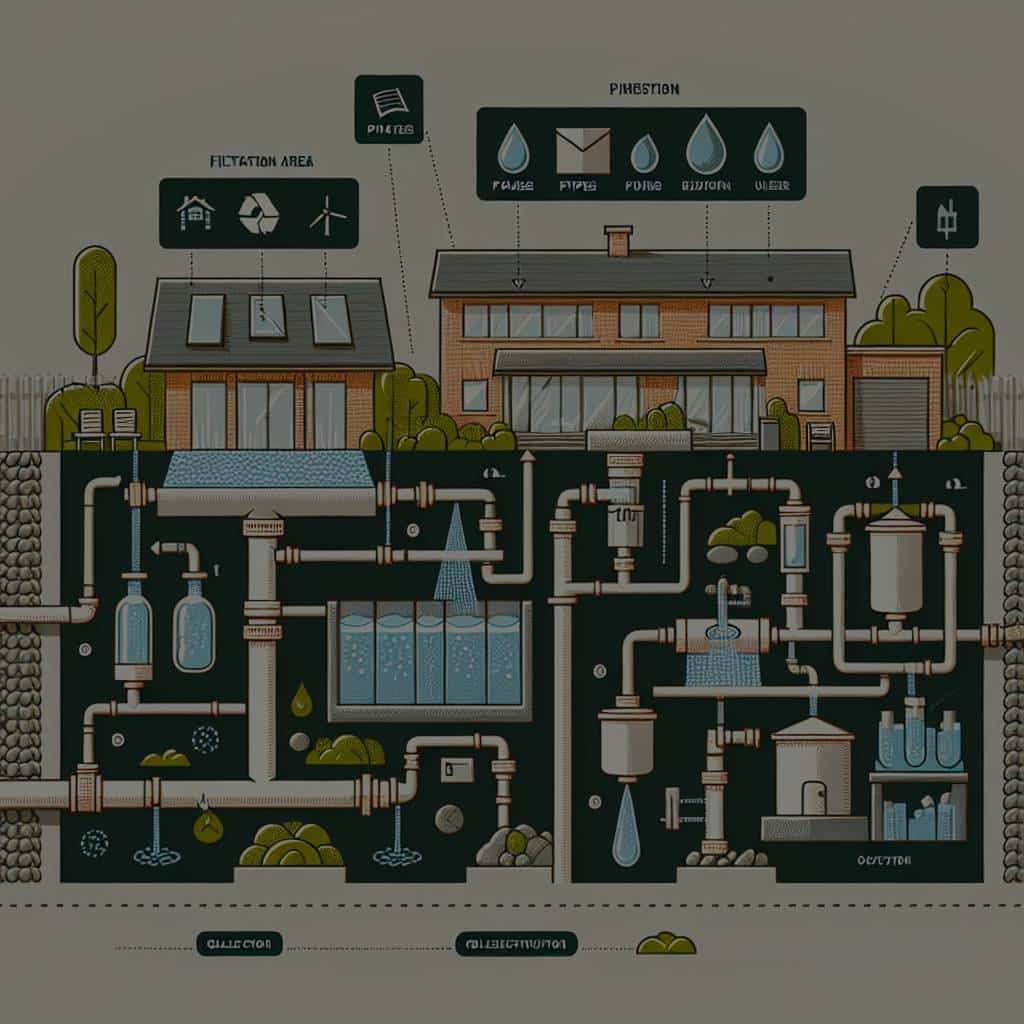Amidst escalating water shortages and the mounting urgency to conserve this precious resource, the utilization of greywater systems in suburban homes is increasingly gaining traction. Greywater refers to the used water from your home that comes from sources such as your bathroom sinks, showers, tubs, and washing machines. It doesn’t include water from toilets – that’s considered blackwater. And while greywater may look dirty, it’s a safe and even beneficial source of irrigation water in a garden.
If you’re thinking about ways to make your home more environmentally friendly and cost-effective, installing a greywater system might be an excellent option. This informative guide will help you navigate the essentials of greywater systems, their benefits, and how you can implement one in your suburban home.
Topic to read : What’s the Most Efficient Layout for a Home-Based Professional Podcast Studio?
Understanding Greywater Systems
Before delving into the implementation process, it’s crucial to understand what greywater systems are and how they function. These systems are designed to redirect and recycle greywater from your house, which would otherwise go to waste, for beneficial purposes like irrigation and toilet flushing.
Greywater systems range from simple, manual bucketing systems to sophisticated, automated systems with advanced treatment processes. The latter can be more expensive but offer significant advantages, such as removing harmful bacteria and particles from the water before reuse.
In parallel : How to Design a Small Home Theater with Acoustic Enhancements for Optimal Sound?
When well-maintained, a greywater system can save a significant amount of water. In fact, greywater systems can recycle up to 70% of your household water.
Selecting the Right Greywater System
Choosing the right greywater system for your home largely depends on your lifestyle, budget, available space, and your state’s regulations on greywater recycling. For instance, if you live in a drought-prone area or have a large garden to maintain, an advanced system might be worth the investment.
The two main types of systems are the gravity-fed manual systems and the packaged or branched drain systems. The former is less costly but requires more effort as you’ll need to manually direct the greywater to your landscape. On the other hand, the latter is more expensive but fully automated, making it a convenient option for busy homeowners.
When selecting a system, consider the availability of local expertise for installation and maintenance. Without proper treatment and handling, greywater can pose health risks, which underscores the importance of professional setup and care.
Implementing a Greywater System in Your Home
Once you’ve chosen a greywater system that suits your home and needs, the next step is implementation. Begin by evaluating your home’s current water usage and identifying which sources can be used for greywater. Common sources include laundry, shower, and bathroom sink water.
Next, decide on where the greywater will be directed. This could be your garden, lawn, or even indoor plants. However, remember that greywater should not remain stagnant for more than 24 hours due to potential bacterial growth.
The installation process will vary depending on whether you’ve chosen a manual or a branched drain system. Regardless, it’s advised to seek professional help to ensure the system is correctly installed and compliant with local regulations.
Greywater System Costs and Maintenance
The cost of a greywater system varies depending on the size, complexity, and whether you’ve gone for a manual or automated system. A simple laundry-to-landscape system could cost around $1000, while more elaborate systems might cost several thousand dollars.
Moreover, upkeep is a critical part of having a greywater system. Regular maintenance includes cleaning filters, checking for leaks, and ensuring that your plants are responding well to the greywater irrigation.
The Environmental and Financial Benefits of a Greywater System
Installing a greywater system in your home not only saves you money by reducing your water bills, but it’s also a great step towards a more sustainable lifestyle. Greywater recycling significantly reduces the demand for fresh water, conserving a resource that’s becoming increasingly scarce.
Simultaneously, greywater systems can reduce your home’s water consumption by nearly half, resulting in substantial savings over time. Additionally, by using greywater for irrigation, you’re giving your plants a nutrient-rich water source, which can lead to a healthier, more vibrant landscape.
It’s evident that greywater systems offer a practical and environmentally-friendly solution for suburban homes. While implementing one may require an upfront investment and ongoing maintenance, the long-term benefits for both your wallet and the planet make it an investment worth considering.
Comprehensive Greywater Treatment Techniques
The quality of greywater can vary greatly depending on the source. Therefore, greywater treatment is an integral part of a greywater system. Treatment methods can range from simple filtration to more advanced techniques that remove bacteria and other contaminants.
In a basic filtration system, the greywater passes through a filter before being used for irrigation. This removes larger particles and some bacteria. However, it’s not foolproof and may not remove all contaminants. If you’re using greywater from your washing machine or laundry, be mindful of the detergents and other chemicals that may not be plant-friendly.
For a more thorough cleaning, you can opt for a treatment system that includes disinfection. This could involve a chlorination process or UV sterilization. These systems, while more expensive, provide a higher level of assurance in terms of water quality.
Another advanced treatment method involves the use of constructed wetlands or reed beds. These natural filters use plants to absorb and break down contaminants in the greywater.
Regardless of the treatment method, always remember that untreated greywater should not be stored for more than 24 hours due to potential bacterial growth. Testing the water quality regularly helps ensure the greywater is safe for reuse and doesn’t harm your plants or soil.
Legal Considerations for Greywater Systems
As greywater systems become more prevalent, there have also been increasing regulations on their use. Before installing a greywater system, it’s crucial to understand the legal requirements in your area.
In some areas, the use of greywater for irrigation without treatment is allowed, while other places may require a permit and specific treatment for greywater reuse. It’s also common for regulations to limit the use of greywater to below ground irrigation to avoid potential contact with humans and pets.
Black water, or water from toilets and kitchen sinks, is usually off-limits for reuse due to high levels of harmful bacteria and pathogens.
When planning to install a greywater system, ensure you check with your local health department or relevant authorities for any regulations or requirements. It’s also worth consulting with professionals or reading news blog articles on the topic to keep abreast of the latest developments in greywater recycling.
Conclusion
A greywater system is a viable and valuable addition to any suburban home. It not only helps conserve water but also cuts down your water bills and fosters a more sustainable lifestyle.
The type of system you choose will largely depend on your budget, the availability of space, and your local regulations. Regardless of the system, regular maintenance is important to ensure efficient operation and prevent potential health risks.
While implementing a greywater system may seem daunting, the benefits, both environmental and financial, are substantial. Through careful planning, selecting the right treatment system, and adhering to local laws, you can successfully implement a greywater system in your suburban home, contributing to water conservation efforts and greener living.
Remember, every drop of water saved is a step towards a more sustainable world. Whether you live in a sprawling suburban house or a compact tiny house, making the most of your greywater is a practical and responsible practice.
Greywater recycling is no longer a niche interest but an important part of the solution to our global water crisis. With the right system and approach, we can turn greywater from waste into a resource, furthering our journey towards a sustainable future.











